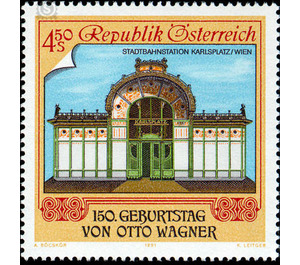150th birthday - Austria / II. Republic of Austria 1991 - 4.50 Shilling
Theme: Architecture
| Country | Austria / II. Republic of Austria |
| Issue Date | 1991 |
| Face Value | 4.50 |
| Color | multi-colored orange blue |
| Printing Type | combination printing |
| Stamp Type | Commemorative |
| Item Type | Stamp |
| Chronological Issue Number | 1378 |
| Chronological Chapter | OOS-OE2 |
| SID | 769318 |
| In 69 Wishlists | |
The master of Viennese Art Nouveau architecture was born on July 13, 1841, the son of a notary in Penzing. He studied from 1857 at the Vienna Technical University and graduated from 1861 to 1863, the architectural class of the Vienna Academy of Fine Arts, whose neat professor he was appointed in 1894. In this function he called for the creation of an architecture derived from the needs of the present, which under the premise of functionality and rationality should produce a rebirth of architecture in a contemporary spirit. The first example of this then revolutionary claim was the installation of the Viennese light rail with the station buildings and auxiliary facilities in the years 1893-1902. Monuments of Art Nouveau architecture set Otto Wagner, among other things, with the Post Office Savings Bank (1904-1912) and his most famous work, the Church of St. Leopold in the State Healing and Nursing at Steinhof (1902-1907). The architect died on April 11, 1918.


